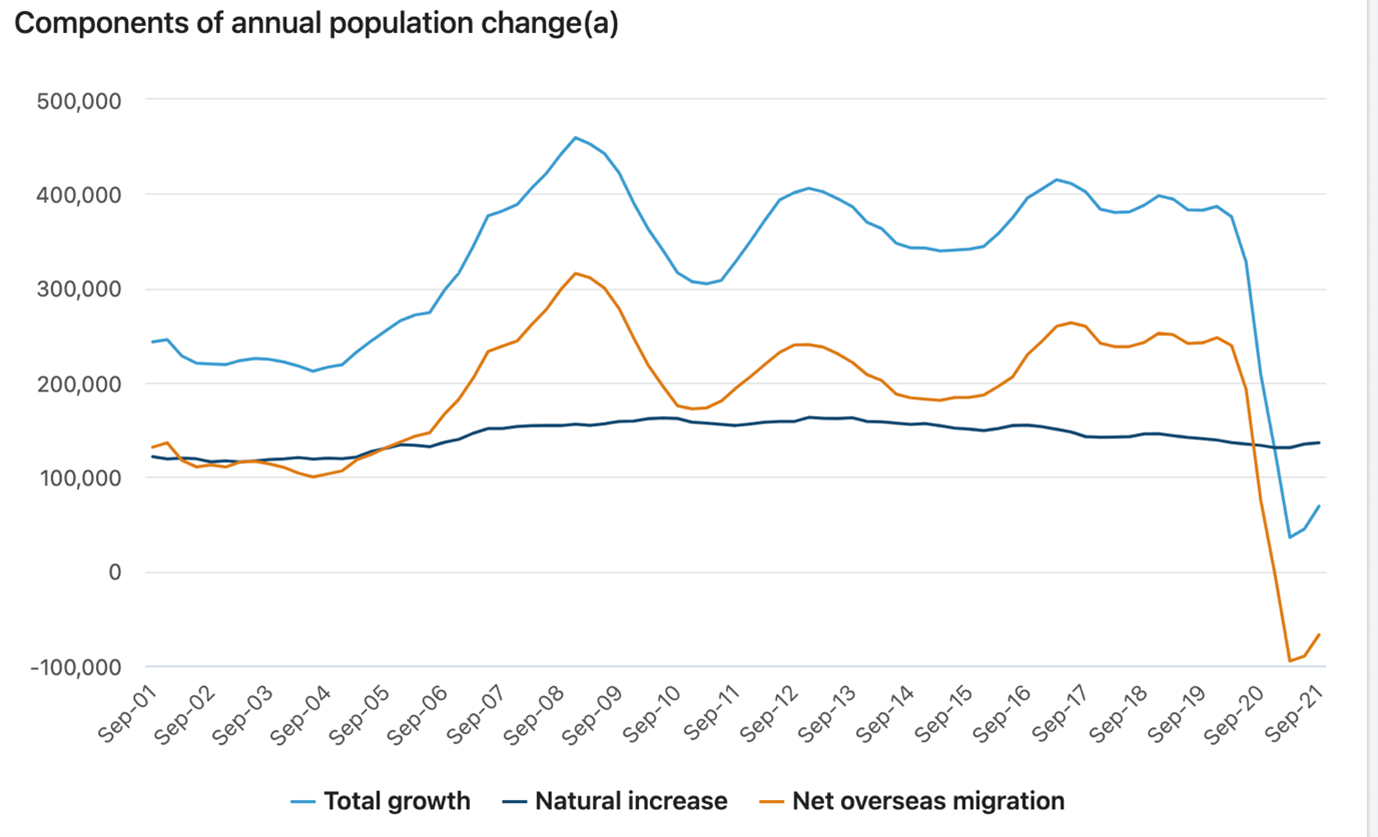
Listen and subscribe
Apple  Android
Android 
In this week’s episode, Dave, Cate and Pete take you through:
New migrants
- We have hovered between 1-2.2% year on year growth for the last twenty years but the last two years have plummeted to close to 0%. That had an enormous impact on a lot of things – employment, universities, capital city markets with smaller dwellings. There is more to the stats than new arrivals, we had returning expats and new births.
- When we think about the cities that were earmarked for growth, they have a higher concentration of new migrants.


People moving out of capital cities, no surprises for Melbourne
- It’s very hard to put a finger on the pulse and say why the moves came about – covid or some people already thinking of moving. People will start to move when housing affordability bites and opportunity presents itself in regions.
- Loss of 32,000 in Melbourne in 2021, Sydney lost almost 20,000. Melbourne was on the road to overtaking Sydney for the most populated city.
- Centre for Population – by 2024-2025 – net overseas migration will have returned to pre-pandemic levels in Melbourne. Along with a significant fall in the net numbers of leavers, the city will again be the fastest growing capital, and by June 2030, the nation’s largest city.
- A lot of state government fueled infrastructure spending – rail upgrades, gearing us up to be a bigger city.


Regional Australia job vacancies
- The five regions with the biggest jumps in vacancies in February 2022 compared with February 2021:
- Geelong & Surf Coast up by 61%
- Ballarat and Central Highlands up by 46.9%
- Outback Queensland up by 41.5%
- Gosford and Central Coast up by 39.8%
- Sunshine Coast up by 39.1%
- Jumps in job vacancies are putting pressure on the businesses in areas that have seen an influx of new people.
- How will it play out? Locals buying in Geelong and Ballarat – interest rates are so low, for some people it’s cheaper to buy than rent. Investors coming back, they don’t do the home work, they just look at the headlines. People knee jerk and don’t realise that they’re jumping on the bandwagon at the tail end.
- People making working from home work, even when hybrid models are introduced.
- Different feeling about regions that are 2 hours and more away – but there has been an uptake of 1 and 2 bedroom units in the city so that they can continue to work from home in a regional area.
- In terms of the occupations being demanded, vacancies are largest for professional roles (24%) of all vacancies in February, followed by Technicians and Trades roles (16%), and Clerical and Administrative roles (14 %).
- We’ve lost 160,000 people coming in from overseas. Unemployment target is to have a 3 in front of it. Migrants will start filling a lot of these jobs. But wage growth needs to be sustainable and ideally higher than inflation. Most international migrants do end up living in the cities, but that’s why they’ve put money in the federal budget to encourage migrants to move to the regions (Regional Home Guarantee).
- How many people are going to stay and keep moving to regional areas and do a commute a few days a week.

Demographics in the regions
- Census data in a few months will provide more insight.
- Problem of people engaged in the work force between age 55 to64 is higher than 64% – these areas will experience a drop in workers as this segment moves into retirement. Barossa, Dubbo, Alice Springs, Port Hedland and Mount Isa.
- Regions continue to be popular for those retiring – sell city, buy in the country and have a lovely retirement.
- Regional Australia Institute:
- The 2016 Census shows that ageing is accelerating in many regions but stable in the cities. Since 2011, the median age for both Sydney and Melbourne didn’t budge from 36 while rising in NSW and Victoria from 41 to 43.
- The Age Pension is already the largest expenditure item in the Federal Budget at $45 billion annually, and if nothing changes, it is forecast to blow out to an unsustainable $51 billion by 2020.
- Victor Harbor, Port-Macquarie-Hastings, and East Gippsland already have 20 per cent or more of the population reliant on the Age Pension.
- The move to the regions is not sustainable – this has happened in the past, but not as prevalent as during covid. We’ll see some regional locations and those without underlying economic strength or further away from CBD be flatter for a prolonged period of time. This has happened to the Gold Coast where it was flat for a long period of time after a great period of migration.
- What could trigger an area coming off? You have to do your home work and each region is it’s own individual market.





